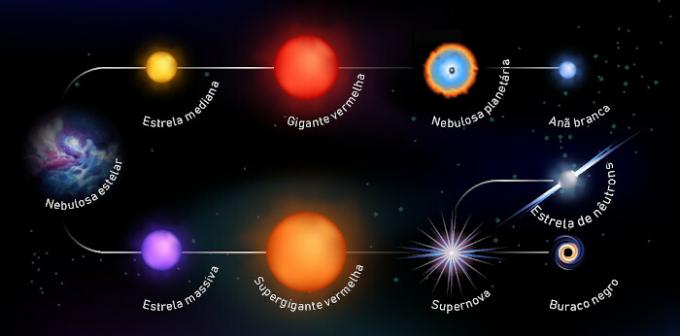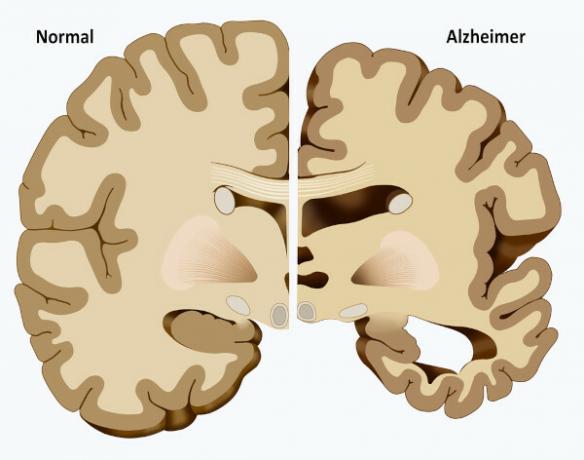stars are celestial bodies formed by gases, such as helium and hydrogen, and dust, with the presence of a dense core inside which fusion reactions take place that result in the release of energy. Stars form in nebulae and can have a lifetime of millions to billions of years, which varies according to their mass. It is difficult to estimate how many stars there are in our Universe today, but some astronomers indicate that the number exceeds 20 digits.
Check out our podcast: Big Bang Theory
Topics of this article
- 1 - Summary about stars
- 2 - Formation of the stars
- 3 - Composition of the stars
- 4 - Characteristics of the stars
- 5 - Types of stars
- 6 - Life and death of the stars
-
7 - Name of the stars
- → List of the 10 brightest stars
- 8 - How many stars are in the sky?
Summary about stars
They are spherical celestial bodies composed of gases such as hydrogen and helium. Inside, there is a nucleus in which nuclear fusion reactions take place, responsible for the energy and light emitted by these objects.
They form inside nebulae from the gravitational collapse of globular nodes.
Its initial stage is called a protostar.
It takes millions of years to reach the mature state, which represents most of their lives. At this stage, thermonuclear reactions begin.
They can have very long life cycles, of billions of years, or short, of millions of years, depending on their mass.
The smaller ones become white dwarfs after this cycle ends. Massive ones end up as neutron stars or black holes.
Its classification is made according to its size and color.
The official name of each is approved by the International Astronomical Union (IAU).
Do not stop now... There's more after the ad ;)
star formation
The process of formation of the stars that make up our Universe begins in clouds composed of dust and gases called nebulae. The interior of nebulae consists of an environment of high turbulence, caused by the movement of gases and other materials. that compose them, giving rise to globular nodes, which can suffer gravitational collapse, the initial phase of the constitution of a star. Thus, several of these structures are formed within the nebulae, which is why these are called star nurseries.
A star in the first stage of its formation process is called a protostar. The gravitational contraction characteristic of this initial phase continues for millions of years, which promotes an increase temperature in the core of protostars and gradually attracts a greater amount of gases and dust to its surroundings.
It is only after a long period has elapsed that the reactions of Nuclear fusion begin to happen in the central region of the stars, when the temperature of this region has already reached at least 15 million degrees Celsius. From then on, the gravitational collapse ceases and there is an equilibrium situation, beginning a new phase of their lives. O Sun, for example, the only star that makes up the Solar system, took 50 million years from its protostar phase to its mature phase.
Composition of the stars
the stars are composed essentially of two gaseous elements, the helium (He) and the hydrogen (H). In their central area, thermonuclear reactions take place, in which hydrogen atoms undergo fusion and give rise to helium atoms. This reaction releases a large amount of energy in the form of heat, and is also responsible for the emission of the characteristic light of stars.
Characteristics of the stars
the stars are spherical celestial bodies and composed of a plasma consisting of gases and dust, notably helium and hydrogen, as we have seen. During the mature phase of their lives, the stars remain in a state of equilibrium due to the forces its own gravitational forces and the pressure exerted by the nucleus thanks to the fusion reactions that take place inside of that structure. This state is called hydrostatic equilibrium.
The size and mass of stars vary considerably depending on factors such as their age and stage. The second aspect, which corresponds to the mass of the stars, is still important for their classification into: low-mass, intermediate, massive, and super-massive. The temperature of the stellar surface can vary between 2500 ºC, in the oldest ones, to almost 50,000 ºC, in the ones that are in the beginning of their mature phase.
The luminosity emitted by stars depends on their age and the amount of energy generated in their core, which decreases over time and the consumption of their fuel, hydrogen.The size and temperature of stars are factors that affect their brightness. The second aspect also determines the coloring of these celestial bodies. Hotter stars are brighter and white or bluish in color, unlike cooler, older stars, which appear reddish.
The age of stars varies from a few million to billions of years. It is estimated that the oldest are practically the same age as our Universe, 13.8 billion years.
types of stars
Stars are classified, according to their mass and color, into:
white dwarfs: are derived from the process of collapse of other main-sequence stars, consisting of their final stage. Despite emitting glow, there are no fusion reactions going on at its core.
yellow dwarfs: have activity in their nucleus, in which nuclear fusion reactions take place. They are part of the main sequence. An example is the Sun.
red dwarfs: are the most present in the Universe. They have small mass, weak brightness and temperatures lower than that of the Sun.
red giants: they are stars in an advanced stage of their life cycle, having a larger size but reduced mass, with less brightness than in the previous stage. In approximately five billion years, the Sun will become a red giant.
Blue giants and supergiants: they are very massive and bright, with extremely high temperatures, ranging between 10,000 K and 50,000 K, in the case of supergiants. These can have up to 25 times the mass of the Sun. Due to the intense activity that occurs in their core, they are also very young stars with a short life cycle.
Interesting:There are also the neutron stars, very small structures, with a diameter of approximately 20 km, massive and extremely dense, being composed essentially of neutrons. They perform circular motion at high speeds, representing the final stage of many massive stars.
Know more: What are shooting stars?
Life and Death of the Stars
Stars form, mature and cease to exist like most celestial bodies in the Universe. The life cycle of a star can last millions or billions of years. A characteristic that all of them present, however, is the fact that their mature phase corresponds to about 90% of the entire cycle.
The way a star evolves until it dies varies with mass., directly related to the presence of fuel gas in its structure for the continuity of the chemical reactions of the nucleus. When these reactions consist of the fusion of hydrogen for the composition of helium, these stars are characterized as main sequence stars. In this case, the hydrogen is consumed until it runs out, causing the core to collapse and the outside of the star to expand until it becomes a red giant.
From then on, the steps that follow depend directly on the mass of the star. In the medium and low-mass stars, activity in the nucleus will continue, but giving rise to atoms of carbon from the fusion of helium. When it comes to an end, the entire mass of the star gives rise to a planetary nebula. The core, in turn, gives rise to a white dwarf.
in the case of massive stars, which have at least seven times the mass of the Sun, the formation of red supergiants occurs. Its core initiates reactions that result in the formation of elements such as iron, the production of which requires an enormous amount of energy. As a result, the star retracts as a reaction of its own gravity and then expands violently through an explosion called a supernova.
Most of its material stays in space, but about 25% will give rise to a neutron star or a Black Hole, which depends on the mass itself. Only supermassive stars form black holes. Watch:

name of the stars
The official name given to the stars must pass the approval of the International Astronomical Union (IAU, in the acronym in English), responsible for its cataloging in order to make it standard for communication and for the studies of these objects. The IAU list features 330 official star names approved so far.
→ List of the 10 brightest stars
To present some examples of star names, we bring the list of the 10 brightest known stars, according to the National Aeronautics and Space Administration (Nowing):
Sirius;
Canopus;
Rigil Kentaurus;
Arcturus;
Vegas;
Chapel;
Rigel;
Procyon;
Achernar;
Betelgeuse.
How many stars are in the sky?
The exact determination of the amount of stars existing in the skies of our Universe is an extremely difficult task, almost impossible. Taking into account only the galaxy in which we are inserted, the Milky Way, it is estimated that there are between 100 and 200 billion stars. In total, the predicted number of stars in the Universe is on the order of 1024 or a septillion.
By Paloma Guitarrara
Geography teacher



